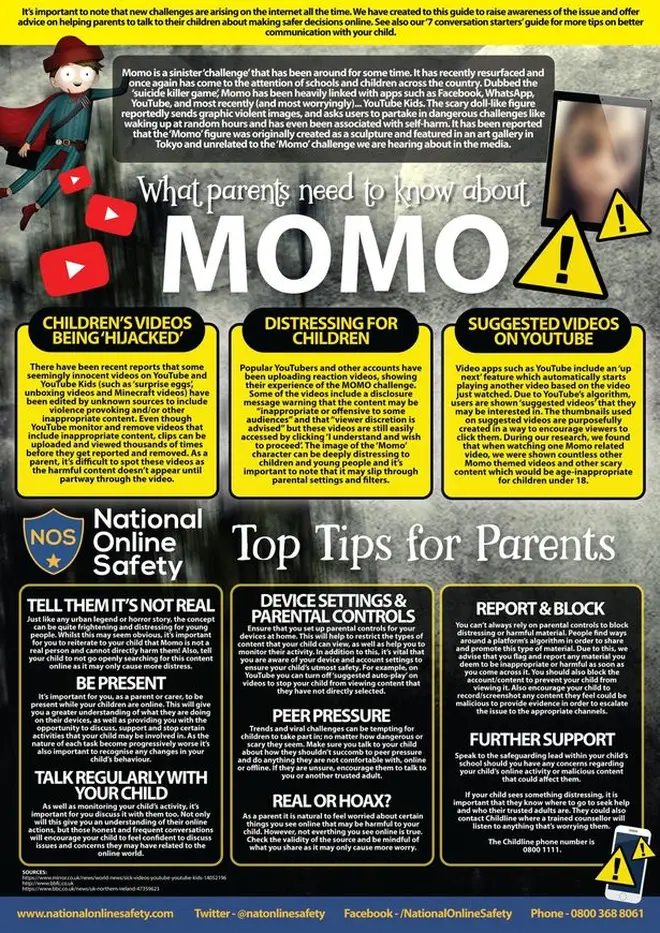Momo challenge: online agency releases vital safety tips for parents and children
27 February 2019, 11:56

How to keep your child safe from the Momo challenge: National Online Safety has released tips on how to handle the sick online game
A twisted online game called The Momo challenge is sweeping the internet, and parents are being given tips on how to handle the terrifying situation.
The game, which is being played via WhatsApp, Facebook and YouTube, is terrifyingly encouraging children to harm themselves - and is being conducted by a hacker calling themselves Momo.
National Online Safety - a group of online safety experts that provides advice for schools - has now issued some tips for parents to keep their kids safe from Momo.
They issued a statement saying: "There have been recent reports that some seemingly innocent videos on YouTube and YouTube Kids (such as ‘surprise eggs’, unboxing videos and Minecraft videos) have been edited by unknown sources to include violence provoking and/or other inappropriate content.
"Even though YouTube monitor and remove videos that include inappropriate content, clips can be uploaded and viewed thousands of times before they get reported and removed.
"As a parent, it’s difficult to spot these videos as the harmful content doesn’t appear until partway through the video."
Keeping your children safe from The Momo Challenge:

The full list of tips issued by National Online Safety on how to talk to your kids about Momo:
1. Tell them it's not real
Just like any urban legend or horror story, the concept can be quite frightening and distressing for young people.Whilst this may seem obvious, it’s important for you to reiterate to your child that Momo is not a real person and cannot directly harm them.
Also, tell your child to not go openly searching for this content online as it may only cause more distress.
2. Be present
It’s important for you, as a parent or carer, to be present while your children are online.
This will give you a greater understanding of what they are doing on their devices, as well as providing you with the opportunity to discuss, support and stop certain activities that your child may be involved in.
As the nature of each task become progressively worse it’s also important to recognise any changes in your child’s behaviour.
3.Talk regularly
As well as monitoring your child’s activity, it’s important for you discuss it with them too.
Not only will this give you an understanding of their online actions, but those honest and frequent conversations will encourage your child to feel confident to discuss issues and concerns they may have related to the online world.
4.Device settings and parental controls
Ensure that you set up parental controls for your devices at home.
This will help to restrict the types of content that your child can view, as well as help you to monitor their activity.In addition to this, it’s vital that you are aware of your device and account settings to ensure your child’s utmost safety.
For example, on YouTube you can turn off ‘suggested auto-play’ on videos to stop your child from viewing content that they have not directly selected.
5.Peer pressure
Trends and viral challenges can be tempting for children to take part in; no matter how dangerous or scary they seem.
Make sure you talk to your child about how they shouldn’t succumb to peer pressure and do anything they are not comfortable with, online or offline.
If they are unsure, encourage them to talk to you or another trusted adult.

6.Real or hoax
As a parent it is natural to feel worried about certain things you see online that may be harmful to your child.However, not everything you see online is true.
Check the validity of the source and be mindful of what you share as it may only cause more worry.
7.Report and block
You can’t always rely on parental controls to block distressing or harmful material.
People find ways around a platform’s algorithm in order to share and promote this type of material.
Due to this, we advise that you flag and report any material you deem to be inappropriate or harmful as soon as you come across it.You should also block the account/content to prevent your child from viewing it.






















